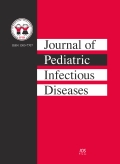Authors: Bhat, Deepak
Article Type:
Research Article
Abstract:
Acute disseminated encephalomyelitis (ADEM) is a rare central nervous system manifestation of dengue hemorrhagic fever. We report a 14-year-old male who presented to the emergency department with complaints of fever, vomiting and headache for last 6 days and altered sensorium for last 1 day. On general physical examination, he had multiple petechial spots over the trunk. In central nervous system examination child was having neck stiffness, intermittent decerebrate posturing, brisk deep tendon reflexes, hypertonia in
…all the limbs, bilateral plantars extensors and sluggishly reacting small pupils. His initial investigations revealed hemoglobin of 12 g/dL, total white cell count 7.500 cells/mm^{3} , platelet count 70,000 cells /mm^{3} , urea 59 mg/dL, creatinine 0.9 mg/dL, calcium 9.1 mg/dL, sodium 140 mEq/L, potassium 4.6 mEq/L and a positive dengue IgM (39.4 panbio units, normal < 11 panbio units) by capture enzyme-linked immunosorbent assay method (PAN BIO KIT, Australia). In view of fever, petechial spots, shock, low platelet counts and a positive dengue serology, a diagnosis of dengue hemorrhagic fever was kept. Magnetic resonance imaging report showed symmetrical hyperintensities on T2-weighted and fluid-attenuated inversion recovery images involving bilateral cerebellar hemispheres, bilateral middle cerebellar peduncles, brain stem, bilateral thalami, hypothalamus and periventricular deep and subcortical white matter, suggesting ADEM. Previously only two cases of ADEM in dengue fever have been reported.
Show more
Keywords: Dengue hemorrhagic fever, child, central nervous system, complication, ADEM
DOI: 10.3233/JPI-2010-0280
Citation: Journal of Pediatric Infectious Diseases,
vol. 5, no. 4, pp. 415-417, 2010
Price: EUR 27.50





